Category: History
Combat Strike Operations Order 35
509th Composite Group U.S. Army Air Force
Taking off from Tinian island at approximately 2:45 a.m. with Colonel Paul Tibbets as command pilot of the ‘Enola Gay‘, the B-29 ascended to operational altitude as it flew to Iwo Jima island to rendezvous just before 6:00 a.m. with the accompanying observation and photography aircraft
At 08:09, Colonel Tibbets started his bomb run over Hiroshima and handed control over to his bombardier, Major Thomas Ferebee.
The release at 08:15 went as planned, and the gun type atomic bomb containing about 141 pounds of uranium-235 took 44.4 seconds to fall from the aircraft flying at about 31,000 feet to a detonation height of about 1,900 feet above the city.
Due to a crosswind, the bomb missed the aiming point, the Aioi Bridge, by approximately 800 feet and detonated directly over Shima Surgical Clinic with the force equivalent to 16 kilotons of TNT.
The radius of total destruction was about 1 mile, with resulting fires across 4.4 square miles.
Around 70,000 to 80,000 people, including 12 U.S. prisoners of war, were killed and another 70,000 injured.
Lewis, Clark, and the Girandoni Air Rifle
**************
About the Declaration there is a finality that is exceedingly restful. It is often asserted that the world has made a great deal of progress since 1776, that we have had new thoughts and new experiences which have given us a great advance over the people of that day, and that we may therefore very well discard their conclusions for something more modern.
But that reasoning can not be applied to this great charter.
If all men are created equal, that is final.
If they are endowed with inalienable rights, that is final.
If governments derive their just powers from the consent of the governed, that is final.
No advance, no progress can be made beyond these propositions.
If anyone wishes to deny their truth or their soundness, the only direction in which he can proceed historically is not forward, but backward toward the time when there was no equality, no rights of the individual, no rule of the people.
Those who wish to proceed in that direction can not lay claim to progress.
They are reactionary.
Their ideas are not more modern, but more ancient, than those of the Revolutionary fathers…………………
After 82 Years, a Hero’s Remains Are Coming Home
World War II was one of history’s deadliest conflicts. The Pacific theater of that conflict was particularly nasty; my mother’s oldest brother served as a Marine in that theater and harbored bad feelings towards Japan for the rest of his life, despite that nation’s dramatic post-war changes. And in that theater, one of the greatest war crimes was the Bataan Death March.
In that event, roughly 76,000 prisoners of war, 10,000 of them Americans, the balance Filipinos, were force-marched from the tip of the Bataan Peninsula to a town called San Fernando, where they were crammed in rail cars and taken to Capas, where they were forced to walk another seven miles to the former training base, Camp O’Donnell, where they were held prisoner. Only 54,000 of the original 76,000 survived the march; captives were beaten, shot, bayoneted, and beheaded en route if they faltered or fell. After reaching Camp O’Donnell and until the end of the war, 26,000 more Filipinos and 1,500 Americans died while being held as POWs by the Japanese. Many of those who died were buried in mass graves, and since the end of the war, the United States has been making efforts to identify remains and bring them home for burial.
Today we learn that the remains of one more American serviceman are, after 82 years, coming home.
A 20-year-old soldier from Louisiana who died as a prisoner of war during World War II has been accounted for, the Defense POW/MIA Accounting Agency (DPAA) said Monday.
U.S. Army Pfc. Joseph C. Murphy was serving in the 31st Infantry Regiment in the Philippines in 1942. While he was serving, Japanese forces invaded the Philippine Islands, sparking months of intense fighting in the region. During this time, thousands of U.S. and Filipino service members were captured as prisoners of war.
Murphy was among those reported captured when U.S. soldiers in the Bataan peninsula surrendered to Japanese forces, the DPAA said, and was one of tens of thousands of POWs subjected to the Bataan Death March in the spring of 1942. After the 65-mile trek, Murphy and other soldiers were held at the Cabanatuan POW Camp #1.
Murphy’s remains were identified after an effort began in 2019 to use DNA as well as dental records and other anthropological data to identify the remains.
It’s to the credit of the DPAA that, after over eight decades, this effort is still ongoing and they are still bringing our men home. It’s a painstaking process; of that we can have no doubt, but it’s worth doing, even at this distance in time. Not only does it show respect for our fallen from that conflict, but it serves as reassurance to today’s soldiers, airmen, sailors, and Marines that if you fall in a foreign land, America will spare no effort to bring your remains back.
Now that he has been accounted for, a rosette will be placed besides Murphy’s name on the Walls of the Missing at the Manila American Cemetery and Memorial. He will be buried in his Louisiana hometown in early August.
This is the proper form. Thousands of Americans fell in the Bataan Death March and the subsequent imprisonment. The legitimate roles of our federal government are few, but expending some resources to identify those who have fallen defending our nation and our constitution is a worthwhile effort, and we can hope that Pfc. Murphy’s family, at long last, has some closure.
The Salvation Army Celebrates the True Meaning of National Donut Day
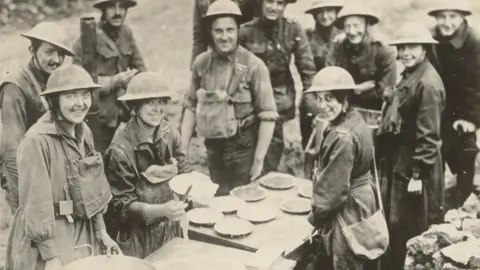
Many Americans don’t know that National Donut Day actually has its roots in doing good. Celebrated on the first Friday in June, this sweet tradition dates back to World War I, when nearly 250 Salvation Army volunteers known as “Donut Lassies” traveled overseas to provide emotional and spiritual support as well as fried confections, supplies, and other services to troops on the front lines.
The original donuts were fried in small pans on the front lines, and the Lassies are credited with popularizing the donut in the United States when troops returned home from war. The Salvation Army in Chicago celebrated the first National Donut Day in 1938 to commemorate their work and help those in need during the Great Depression.
That same spirit of service continues to this day. For more than a century the organization has provided a wide range of essential services like food, shelter, and emotional and spiritual support to the most vulnerable and to the men and women serving on the front lines of need.
“Whether glazed or cake, and whatever the toppings, donuts represent our long history of providing hope and comfort – from our volunteers in the trenches of war to our continued service on the front lines of need,” said Commissioner Kenneth Hodder, National Commander of The Salvation Army. “Knowing that National Donut Day has its roots in the ‘fight for good’ makes these treats taste even sweeter.”
6 June 1944, United Kingdom
Soldiers, Sailors and Airmen of the Allied Expeditionary Forces:
You are about to embark upon the Great Crusade, toward which we have striven these many months. The eyes of the world are upon you. The hopes and prayers of liberty-loving people everywhere march with you. In company with our brave Allies and brothers-in-arms on other Fronts you will bring about the destruction of the German war machine, the elimination of Nazi tyranny over oppressed peoples of Europe, and security for ourselves in a free world.
Your task will not be an easy one. Your enemy is well trained, well equipped and battle-hardened. He will fight savagely.
But this is the year 1944. Much has happened since the Nazi triumphs of 1940-41. The United Nations have inflicted upon the Germans great defeats, in open battle, man-to-man. Our air offensive has seriously reduced their strength in the air and their capacity to wage war on the ground. Our Home Fronts have given us an overwhelming superiority in weapons and munitions of war, and placed at our disposal great reserves of trained fighting men. The tide has turned. The free men of the world are marching together to victory.
I have full confidence in your courage, devotion to duty, and skill in battle. We will accept nothing less than full victory.
Good Luck! And let us all beseech the blessing of Almighty God upon this great and noble undertaking.
“Twilight, you say? Listen to H.G. Wells. H.G. Wells says: “The past is but the beginning of a beginning, and all that is and has been is but the twilight of the dawn.” Well, that’s a new day – our sunlit new day – to keep alive the fire so that when we look back at the time of choosing, we can say that we did all that could be done – never less.”
-Ronald Reagan 1988
REMINDER: It’s Victims of Communism Day.
Today is May Day. Since 2007, I have advocated using this date as an international Victims of Communism Day. I outlined the rationale for this proposal (which was not my original idea) in my very first post on the subject:
May Day began as a holiday for socialists and labor union activists, not just communists. But over time, the date was taken over by the Soviet Union and other communist regimes and used as a propaganda tool to prop up their [authority]. I suggest that we instead use it as a day to commemorate those regimes’ millions of victims.
The authoritative Black Book of Communism estimates the total at 80 to 100 million dead, greater than that caused by all other twentieth century tyrannies combined. We appropriately have a Holocaust Memorial Day. It is equally appropriate to commemorate the victims of the twentieth century’s other great totalitarian tyranny. And May Day is the most fitting day to do so….
Our comparative neglect of communist crimes has serious costs. Victims of Communism Day can serve the dual purpose of appropriately commemorating the millions of victims, and diminishing the likelihood that such atrocities will recur. Just as Holocaust Memorial Day and other similar events promote awareness of the dangers of racism, anti-Semitism, and radical nationalism, so Victims of Communism Day can increase awareness of the dangers of left-wing forms of totalitarianism, and government domination of the economy and civil society.
While communism is most closely associated with Russia, where the first communist regime was established, it had equally horrendous effects in other nations around the world. The highest death toll for a communist regime was not in Russia, but in China. Mao Zedong’s Great Leap Forward was likely the biggest episode of mass murder in the entire history of the world.
May 1, 2024
The Roman poet Ovid wrote in his Book Of Days that the month of May is named for the maiores, Latin for “elders,” and that the following month, June is named for the iuniores, or “young people”
Today is Camerone Day, the anniversary of the Battle of Camerone.
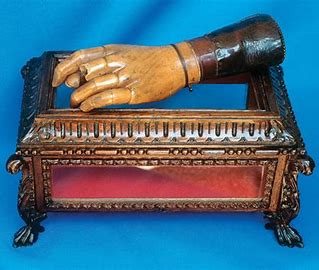
On this day in 1863, 3 officers and 62 men of the French Foreign Legion exemplified stoic determination in the face of overwhelming odds.
The Legionnaires under Captain Jean Danjou, retreating in good order from Palo Verde as a diversion, made a stand in an hacienda in the Mexican town of Camarón de Tejeda and were surrounded by as many as 2000 Mexican troops.
When called on to surrender, by Colonel Francisco de Paula Milán, the Mexican commander, Captain Danjou replied, “We have munitions. We will not surrender.”
In the ensuing battle, nearly all of the Legionnaires, including Captain Danjou, were killed. When the last 5 unwounded men ran out of ammunition, under the command of Lieutenant Maudet, they loaded their last round, fixed bayonets, and charged the enemy.
Inevitably, they were surrounded and captured. The last remaining NCO, Corporal Maine, insisted that the wounded be treated, the survivors be sent with their arms back to France, and that the body of Captain Danjou be escorted for a proper military burial. Colonel Milan reportedly said; “Que podré negar a cierto hombres? No, estos no son hombres, son demonios.” What can I refuse to such men? No, these are not men, they are devils.
The Foreign Legion celebrates this day as an annual holiday where, on parade, the wooden prosthetic hand of Captain Danjou is carried as a high honor.
Today, my Dad, already ‘The Elder’ of the clan, as the oldest living, becomes the oldest ever lived, as he surpasses the age of his older brother who passed in February of 2021, a little less than 5 months before his centenary birthday.
Yes, Dad is “Ninety and Nine”, and in September will celebrate his 100th birthday, having proclaimed on more than one occasion that he plans on casting his vote in the 2024 federal election.
Combine a small apocalyptic sect with one of its major prophecies being fulfilled, as they saw it, by a law enforcement agency who it is said were looking for headlines to bolster its reputation for an increased budget, and what you wind up with is this.
The Waco Siege: What Happened When the Feds Laid Siege to the Branch Davidian Compound
“The record of the Waco incident documents mistakes. What the record from Waco does not evidence, however, is any improper motive or intent on the part of law enforcement.”
The siege of the Branch Davidian compound in Waco, Texas, is an important event in American history because it directly led to one of the biggest terrorist attacks on American soil – the bombing of the Oklahoma City Federal Building. It’s not necessary to defend this act of terrorism to understand why the entire freedom movement of the time was so incensed by it. Indeed, it stood as a symbol of federal overreach and the corruption of the Clinton Administration.
It’s important to separate fact from fiction when it comes to the siege of Waco, just as it is important to do so with the siege of Ruby Ridge or the attack on the American consulate in Benghazi. With every event, it is important to stick to the facts and what can be extrapolated from them to make the strongest argument about what went wrong and why, and what could be done differently in the future.
The Amazing True Story Of The Real St. Patrick
St. Patrick really existed, and the ripple effects of what he accomplished during his lifetime are still being felt today. Sadly, very few people know the true story of this remarkable man. If you have a few moments, please let me share that story with you. Once you understand what really happened, you will never view St. Patrick’s Day the same way again. Today, most people regard St. Patrick’s Day as an excuse to wear green and get drunk. According to Wikipedia, St. Patrick’s Day is celebrated in more nations “than any other national festival”…
Saint Patrick’s Day is a public holiday in the Republic of Ireland,[13] Northern Ireland,[14] the Canadian province of Newfoundland and Labrador (for provincial government employees), and the British Overseas Territory of Montserrat. It is also widely celebrated in the United Kingdom,[15] Canada, Brazil, United States, Argentina, Australia, South Africa,[16] and New Zealand, especially amongst Irish diaspora. Saint Patrick’s Day is celebrated in more countries than any other national festival.[17] Modern celebrations have been greatly influenced by those of the Irish diaspora, particularly those that developed in North America. However, there has been criticism of Saint Patrick’s Day celebrations for having become too commercialised and for fostering negative stereotypes of the Irish people.[18]
So was there an actual historical figure that inspired this holiday?
Yes, but the truth is that the real St. Patrick wasn’t even Irish.
Maewyn Succat was born in Britain some time around AD 387 to Christian parents.
But he did not embrace the faith of his parents during his youth.
In fact, he considered himself to be “idle and callow” when he was a boy.
A turning point came when he was taken captive by Irish raiders at the age of 16…
At the age of 16, Patrick was taken prisoner by a group of Irish raiders who were attacking his family’s estate. They transported him to Ireland where he spent six years in captivity. (There is some dispute over where this captivity took place. Although many believe he was taken to live in Mount Slemish in County Antrim, it is more likely that he was held in County Mayo near Killala.)
During this time, he worked as a shepherd, outdoors and away from people. Lonely and afraid, he turned to his religion for solace, becoming a devout Christian. (It is also believed that Patrick first began to dream of converting the Irish people to Christianity during his captivity.)
He was finally able to escape after six years in Ireland, and he was reunited with his family.
But some time later he was instructed in a dream to return to Ireland as a missionary…
After more than six years as a prisoner, Patrick escaped. According to his writing, a voice—which he believed to be God’s—spoke to him in a dream, telling him it was time to leave Ireland.
To do so, Patrick walked from County Mayo, where it is believed he was held, to the Irish coast. After escaping to Britain, Patrick reported that he experienced a second revelation—an angel in a dream tells him to return to Ireland as a missionary.
Patrick’s return to Ireland was spectacularly successful.
Welcome Back Daylight Saving Time
Daylight Saving Time was first implemented in the U.S. with the Standard Time Act of 1918, a wartime measure for seven months during World War I in the interest of adding more daylight hours to conserve energy resources.
“War Time”, full time DST was implemented again during World War II.
After the war, local jurisdictions were free to choose if and when to observe DST until the Uniform Time Act which standardized DST in 1966.
Permanent DST was enacted for the winter of 1974, but there were complaints of children going to school in the dark and working people commuting and starting their work day in pitch darkness during the winter, and it was repealed a year later.
Today, back in 1945.
Raising the 1st flag over Mt Suribachi
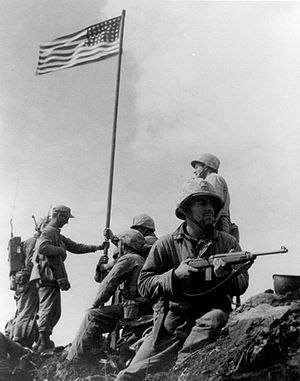
Raising the 2nd flag.
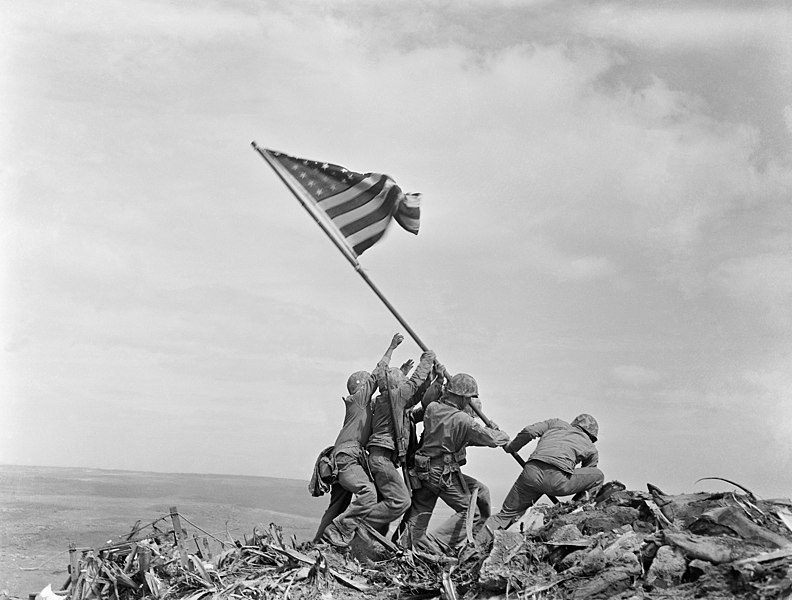
Lowering the 1st flag as the 2nd is raised.

February 23 marks the day the United States Marines raised America’s flag over Mount Suribachi in Japan during the Battle of Iwo Jima almost 80 years ago.
The moment has been immortalized in a famous photograph taken by Associated Press photographer Joe Rosenthal.
Battle of Iwo Jima
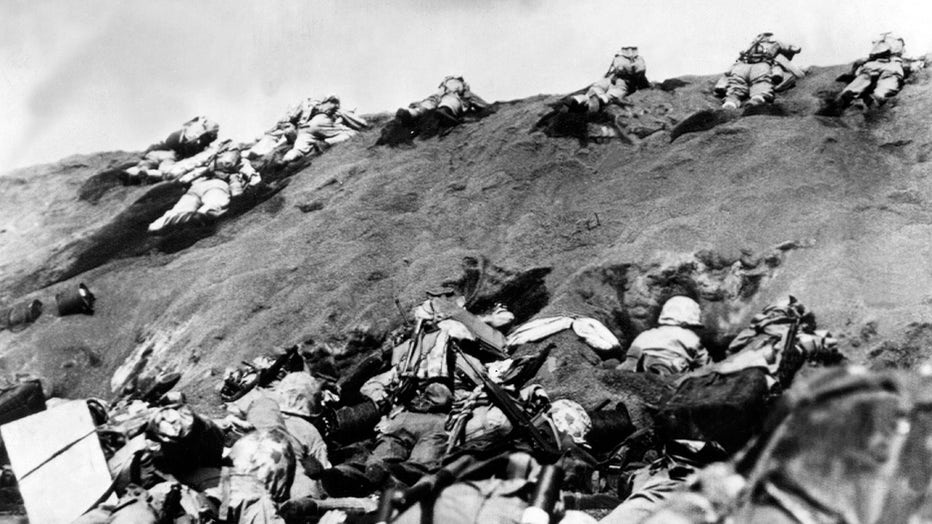
American soldiers fighting against the Japanese in Iwo Jima on March 1945. (Photo by Keystone-France/Gamma-Keystone via Getty Images)
The Battle of Iwo Jima began after American forces invaded the island on Feb. 19, 1945.
The battle lasted for five weeks and was considered one of the bloodiest military campaigns of World War II and in the history of the Marine Corps, according to The National WWII Museum.
It was estimated that almost 7,000 Marines lost their lives and all but roughly 200 of the 21,000 Japanese forces were killed, according to History.com.
Following the capture of Iwo Jima, the longest and largest battle in the Pacific took place during the invasion of Okinawa, Japan.
Twenty-seven Medals of Honor were awarded to service members for their actions at Iwo Jima – the most in the history of the U.S., according to The National WWII Museum.
Flag raising on Iwo Jima
On Feb. 23, 1945, U.S. forces took Mount Suribachi and were photographed raising the American flag at the summit.
The iconic photo won Rosenthal, the photographer, a Pulitzer Prize.
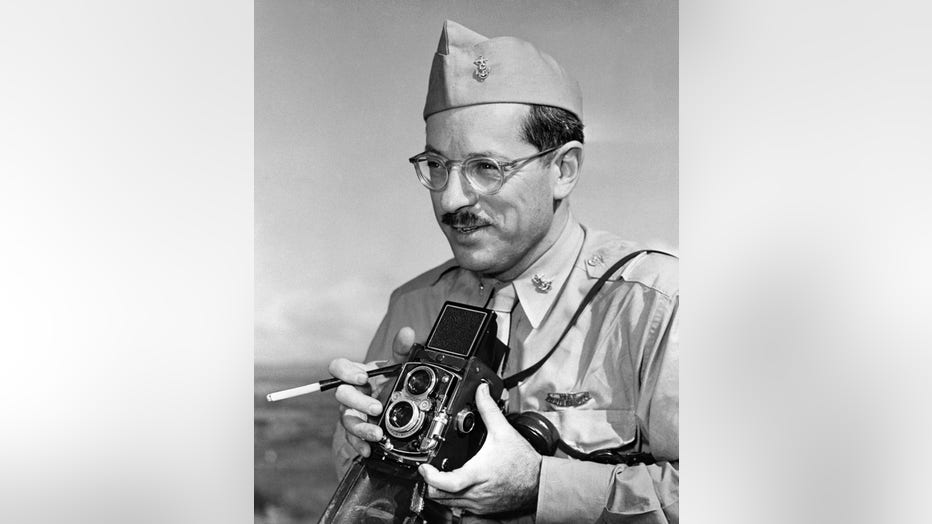
Joe Rosenthal, a veteran AP cameraman, who took the famous picture of the flag raising at Iwo Jima, holding camera. (Bettmann via Getty Images)
That photo shows the second flag that was erected on the mountain. A photo of the first flag that was raised shows a completely different angle and a completely different flag.
As several Marines raised the first flag on Mount Suribachi, Marine Staff Sgt. Louis Lowrey from Leatherneck Magazine captured a photo. However, after that first flag was raised, Japanese forces began to shoot and Lowrey ended up dropping his camera while ducking for cover, according to Military.com.
As Lowrey descended the mountain to get new gear, AP photographer Rosenthal was ascending the mountain.
In response to seeing Japanese forces’ reaction to the flag being erected on the mountain, Marine Corps Lt. Col. Chandler Johnson ordered for a new and larger American flag to be raised, according to the Marines website.
This new flag raising was the moment Rosenthal captured and became one of the most famous photos in American history.
Who raised the Iwo Jima flags?
The service members who raised the first flag on Mount Suribachi were: 1st Lt. Harold G. Schrier, Plt. Sgt. Ernest I. Thomas, Jr., Sgt. Henry O. Hansen, Cpl. Charles W. Lindberg, Pharmacist Mate 2nd Class John H. Bradley and Pvt. Philip L. Ward, according to the Marine Corps website.
Following Iwo Jima, Schrier fought in the Korean War and was promoted to Major in 1951. He would retire from the Marines as a lieutenant colonel, according to the Military Hall of Honor website. He died in 1971 in Florida.
Lindberg said that many did not believe him when he said he helped raise one of the two flags in Iwo Jima, according to a New York Times report.
Lindberg spent his final years raising awareness about the first flag-raising and spoke at veterans groups and schools, The Times said.
He died in June of 2007.
Bradley, who was originally misidentified in the photo of the second (more famous) flag raising, passed away in 1994 and his son, James Bradley, later wrote a book titled “Flags of Our Fathers” in 2000. The book’s storyline centered around the flag-raising in Iwo Jima and the famous photograph that came from it. A movie adaptation of the book directed by Clint Eastwood was released in 2006, according to IMDB.
Controversy surrounded the book after it was found that some of the Marines, including Bradley, in the second flag-raising photograph were misidentified.
The Marine Corps formally recognized the misidentification and in 2016, a corrected list of names for both the first flag-raising and second were released.
Ward was one of the Marines not identified as one of the original men who helped raise the first flag on Mount Suribachi and was part of the amended list of Marines released in 2016.
Ward was posthumously recognized for his part in the battle as he died on Dec. 28, 2005, according to We Are the Mighty.
Thomas and Hansen died in battle.
Those who were responsible for the second flag-raising were: Pfc. Harold Keller, Pfc. Harold Schultz, Cpl. Harlon Block, Pfc. Franklin Sousley, Sgt. Michael Strank and Pfc. Ira Hayes.
In 2019, the Marine Corps, in collaboration with the Federal Bureau of Investigation and historian Brent Westmeyer, revealed that Keller was misidentified as Cop. Rene Gagnon in the famous photograph of the second flag-raising.
Keller survived the war and went back home to Iowa where he lived with his wife Ruby and three children until he died of a heart attack in 1979, according to the Des Moines Register.
Hayes, who was a member of the Pima Indian Tribe, was dubbed a war hero by President Dwight D. Eisenhower when he returned to the U.S.
Hayes struggled with PTSD and survivor’s guilt, according to the Museum of Native American History. He died at the age of 32 near his home in Sacaton, Arizona.
Schultz returned to the U.S. and worked for the Postal Service until his retirement in 1981, according to We Are The Mighty.
He seldomly spoke of his time in the war and only revealed any details to his stepdaughter, Dezreen Macdowell. She would go on to be interviewed by Time Magazine and lauded her stepfather as a war hero.
Schultz died on May 16, 1955.
Block, Strank and Sousley were killed in action in Iwo Jima.
George Washington: Original American Badass
Today is “Presidents’ Day,” a rather lifeless midwinter holiday that gives some people a three-day holiday and retailers the chance to flog Chinese-made consumer goods at a discount. It wasn’t always so. Before 1970, it was Washington’s Birthday, in honor of our first president, and, if you’ll stick with me through this story, a genuine American badass.
Most (I hope) Americans know he was our first president. More probably know about his false teeth and, now that the destruction of American culture is the thing, that he owned slaves than know about his life. When most people think of George Washington, they think of a rather stiff figure in a wig. Nothing could be farther from the truth. Our first president was a badass in his own right.
At a time when Europeans born in America were about 5 feet 4 inches, George Washington stood 6 feet 3 inches. He was athletic and had a charisma that attracted the attention and admiration of men and women. The scion of minor Tidewater gentry, Washington could’ve led a comparatively easy life as a planter. But that wasn’t his style. He was called to an active life that bordered on the reckless.
At the age of seventeen, he was a licensed surveyor. Family connections got him an appointment as the official surveyor of Culpeper County, VA. In 1750, at age eighteen, he began surveying wilderness tracts across the Blue Ridge Mountains in the Shenandoah Valley. Surveying the Shenandoah Valley was not a trivial undertaking.
The Shenandoah was unexplored, and the people who settled there were mostly Irish borderers — or what we now call Scots-Irish to distinguish them from the Irish Catholics who began arriving in the first third of the 19th century — who were not known for docility or paying much attention to the law.
Thomas Jefferson lamented, “The wild Irish, who had gotten possession of the valley between the Blue Ridge and North Mountain, forming a barrier over which none ventured to leap, and would still less venture to settle among.” They gathered there by choice, flowing down the Cumberland Valley from Pennsylvania, as many of them had reason to prefer to be at a distance from authorities. The British Crown wasn’t displeased. They formed a useful barrier between the French and their Indian allies and British settlements east of the Blue Ridge.
While Washington worked under the supervision of more experienced surveyors, he led independent expeditions that required him to give orders to surveying crew members much older and more experienced than he. He had a commanding presence that made that easy for him. In 1752, family influence got him appointed as adjutant general of the Virginia militia, where he quickly made a name for himself. The following year, Virginia’s lieutenant governor, Robert Dinwiddie, gave him a special mission of traveling to Fort Le Boeuf, near Erie, PA, to tell the French to get the hell out of Dodge. If you haven’t read about this mission, you really owe it to yourself. In a 77-day journey in the dead of winter, Washington and his companion, famed frontiersman Christopher Gist, faced attempted murder by Indians loyal to France and nearly died of hypothermia on a snow-covered island after their raft dumped them in an ice-filled Allegheny River.
Later in life, he showed himself physically superior to much younger men. Artist Charles Willson Peale stayed at Mount Vernon for a period in 1773 when Washington was 41 and Peale 33. This is from Peale’s diary.
One afternoon several young gentlemen, visiters at Mount Vernon, and myself were engaged in pitching the bar, one of the athletic sports common in those days, when suddenly the colonel appeared among us.
He requested to be shown the pegs that marked the bounds of our efforts; then, smiling, and without putting off his coat, held out his hand for the missile.
No sooner . . . did the heavy iron bar feel the grasp of his mighty hand than it lost the power of gravitation, and whizzed through the air, striking the ground far, very far, beyond our utmost limits.
We were indeed amazed, as we stood around, all stripped to the buff, with shirt sleeves rolled up, and having thought ourselves very clever fellows, while the colonel, on retiring, pleasantly observed, “When you beat my pitch, young gentlemen, I’ll try again”
At Jumonville Glen, he became the only individual other than Gavrilo Princip to kick off a world war singlehandedly. In the words of Sir Horace Walpole, “A volley fired by a young Virginian in the backwoods of America set the world on fire.” At Braddock’s defeat on the Monongahela, Washington had two horses shot from under him, and four musket balls passed through his clothing.
There’s a lot more to his life, but what marks George Washington as a true badass rather than just a heroic adventurer is an encounter with John Law.
Justice in colonial Virginia and Great Britain in the 18th century was very much a personal matter. If you wanted someone arrested, you had to do the leg work of getting a warrant issued. The local authorities may or may not help you apprehend the villain. When it came to trial, you had to hire a prosecutor.
This saga starts in Frederick County, Virginia, in May 1753. The exact cause is unknown, but this is what we can guess from connecting the dots. Adjutant of the Virginia Militia had prestige and brought Washington into contact with Virginia’s political elite, but it didn’t pay the rather substantial bills associated with running a couple of large farms. Washington seems to have kept his surveying business. We know he was engaged in surveying work in Frederick County in the summer of 1753. He may have been surveying, and he may have been mooning over the love of his life, Sally Fairfax, but that’s a different story.
In May 1753, a local man named John Harrow swore out a writ of capias, a type of bench warrant, against George Washington. The warrant ordered the county sheriff “to take George Washington, Gent. And hold him in your safe custody.” Washington was to answer the charge that he had trespassed on Harrow’s property and caused damages valued at £100. The sheriff attempted to find Washington, but he’d probably passed out of the area. In September 1753, Washington was again surveying the area around Winchester, VA, and the sheriff made another attempt to serve it. But Washington was out of the county before the sheriff’s deputies could find him.
The law’s luck changed for the better the following year. On April 13, 1754, the warrant was issued for a third time. This time, though, the 22-year-old Washington was not a surveyor. He was second-in-command of the Virginia regiment under Colonel Joshua Fry, sent by Lieutenant Governor Dinwiddie to capture Fort Duquesne at what is now Pittsburgh.
Washington departed Alexandria on April 2 with about 120 Virginia militia. He arrived in Winchester on April 10 and waited for the arrival of a local militia company under the command of a company of men raised by a local doctor, Adam Stephen. They were delayed for a week, gathering wagons and supplies. (Side note: wagons were in short supply on the frontier, and farmers were very reluctant to rent them to the army because they were vital to farm work, and the chances of them ever returning from military service were zero. Benjamin Franklin “convinced” Germans in Pennsylvania to lease their wagons to Braddock’s expedition by insinuating if they didn’t give them up, the British would use the tactics of armies in Central Europe. That is, they’d take the wagons and burn the farms. Read his epic broadside to Pennsylvania farmers).
At some point while Washington’s column was encamped at Winchester, Deputy Sheriff William Green arrived and informed Lieutenant Colonel Washington that he was under arrest and would be held in the county lockup until the court met in October. The note on the warrant Green returned to the county court lets us know how that encounter went.
The within named George Washington would not be taken. He kept me off by force of arms.
“By force of arms” means that Washington used either a sword or pistol to convince Deputy Green that he wasn’t interested in cooperating.
At this point, the County Sheriff put the warrant in the “too hard” box. In October, in the aftermath of Fort Necessity and as war with the French loomed, the case was dismissed.
John Harrow appears briefly once again. In the regimental account book of the First Virginia Regiment, John Harrow, a blacksmith, is paid for seven days of work at Fort Loudoun. The commander at the fort was George Washington.
The warrant is viewable on the Library of Virginia website, as is this brief history of the affair.
We’ve had all kinds of men as president, but only one of them started a world war, prevented a military coup against the government of the United States, and used either a sword or pistol to convince a deputy sheriff that he had urgent business back at the office; that was George Washington, the original American badass.

